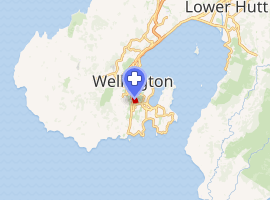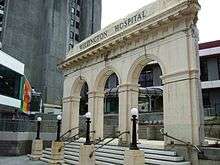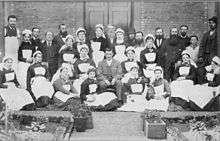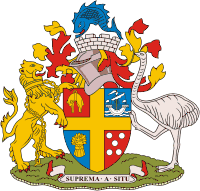Wellington Hospital, New Zealand
Wellington Hospital, also known as Wellington Regional Hospital, is the main hospital in Wellington, New Zealand, located south of the city centre in the suburb of Newtown. It is the main hospital run by Capital & Coast District Health Board (C&CDHB), which serves Wellington City, Porirua and the Kapiti Coast District. (Lower Hutt and Upper Hutt have a separate district health board, the Hutt Valley DHB, and a separate hospital, Hutt Hospital, in the Lower Hutt suburb of Boulcott.)
| Wellington Hospital | |
|---|---|
| District Health Board | |

| |
| Geography | |
| Location | Newtown, Wellington, New Zealand |
| Organisation | |
| Funding | Public hospital |
| History | |
| Opened | 1847 |
| Links | |
| Website | Official website |
| Lists | Hospitals in New Zealand |

Wellington Hospital is the Wellington Region's main tertiary hospital, with services such as complex specialist and acute (or "tertiary") services, procedures and treatments such as the Intensive Care Unit, cardiac surgery, cancer care, cardiology procedures, neurosurgery, and renal care. The Hospital is a tertiary referral centre for the lower half of the North Island and the top of the South Island (specifically the Hawke's Bay, Manawatu-Wanganui, Wellington, Tasman, Nelson and Marlborough regions), and for the Chatham Islands.[1]
It is affiliated with the University of Otago and has the Wellington School of Medicine and Health Sciences situated adjacent to the main hospital buildings.
History

The first hospital was established in 1847 to address the needs of the Māori and the poorer local population. This was one of the first four hospitals established by Governor George Grey. He believed that the young and fit settlers would be treated at home but the native New Zealanders might benefit from the European influence of a hospital.[2]
Kate Marsden served here as matron before she returned to Europe and undertook a journey to Siberia to help the lepers. When she was subsequently accused of dishonesty there was mixed support from New Zealand. Reports here recorded that Marsden had referred to the leprosy that the Māoris suffered from. However, there was no evidence of leprosy in New Zealand although the native population did endure a similar disease.[3]
C&CDHB has built a new regional hospital on the existing site known as the NRH Project, the programme of work included demolition of some of the older buildings, refurbishment/upgrade of others and the construction of a new main building including wards spread over 47,830 sq metres – this project was completed in December 2008, at a cost of NZ$265m. The rebuild included a new state-of-the-art 18-bed Intensive Care Unit, a new operating theatre complex, and the uniting of medical & surgical wards into a single building. The newly named Wellington Regional Hospital has been built to withstand considerable earthquake shock waves using technology similar to that used in the construction of Te Papa, New Zealand's National Museum.
In early 2010 Prince William visited the children of Ward 1 and some of Ward 2 (formerly known as Ward 19 and Ward 18).
See also
References
- "New Zealand Out-of-Hospital Major Trauma Destination Policy -- Lower North Island Area" (PDF). National Trauma Network/Te Hononga Whētuki ā-Motu. February 2017.
- Establishment of hospitals in New Zealand, Encyclopedia of New Zealand, retrieved 5 March 2014
- "KATE MARSDEN". The Barrier Miner. Broken Hill, NSW: National Library of Australia. 28 August 1894. p. 2. Retrieved 6 March 2014.
